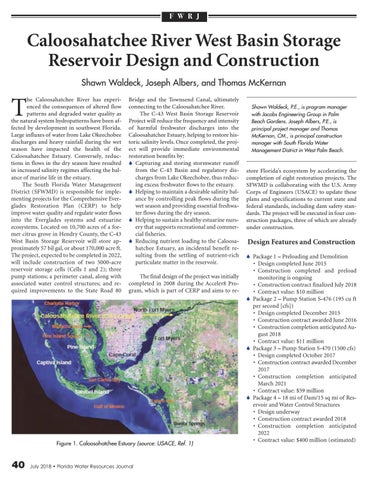F W R J
Caloosahatchee River West Basin Storage Reservoir Design and Construction Shawn Waldeck, Joseph Albers, and Thomas McKernan he Caloosahatchee River has experienced the consequences of altered flow patterns and degraded water quality as the natural system hydropatterns have been affected by development in southwest Florida. Large influxes of water from Lake Okeechobee discharges and heavy rainfall during the wet season have impacted the health of the Caloosahatchee Estuary. Conversely, reductions in flows in the dry season have resulted in increased salinity regimes affecting the balance of marine life in the estuary. The South Florida Water Management District (SFWMD) is responsible for implementing projects for the Comprehensive Everglades Restoration Plan (CERP) to help improve water quality and regulate water flows into the Everglades systems and estuarine ecosystems. Located on 10,700 acres of a former citrus grove in Hendry County, the C-43 West Basin Storage Reservoir will store approximately 57 bil gal, or about 170,000 acre ft. The project, expected to be completed in 2022, will include construction of two 5000-acre reservoir storage cells (Cells 1 and 2); three pump stations; a perimeter canal, along with associated water control structures; and required improvements to the State Road 80
T
Bridge and the Townsend Canal, ultimately connecting to the Caloosahatchee River. The C-43 West Basin Storage Reservoir Project will reduce the frequency and intensity of harmful freshwater discharges into the Caloosahatchee Estuary, helping to restore historic salinity levels. Once completed, the project will provide immediate environmental restoration benefits by: S Capturing and storing stormwater runoff from the C-43 Basin and regulatory discharges from Lake Okeechobee, thus reducing excess freshwater flows to the estuary. S Helping to maintain a desirable salinity balance by controlling peak flows during the wet season and providing essential freshwater flows during the dry season. S Helping to sustain a healthy estuarine nursery that supports recreational and commercial fisheries. S Reducing nutrient loading to the Caloosahatchee Estuary, an incidental benefit resulting from the settling of nutrient-rich particulate matter in the reservoir. The final design of the project was initially completed in 2008 during the Acceler8 Program, which is part of CERP and aims to re-
Figure 1. Caloosahatchee Estuary (source: USACE, Ref. 1)
40
July 2018 • Florida Water Resources Journal
Shawn Waldeck, P.E., is program manager with Jacobs Engineering Group in Palm Beach Gardens. Joseph Albers, P.E., is principal project manager and Thomas McKernan, CM., is principal construction manager with South Florida Water Management District in West Palm Beach.
store Florida’s ecosystem by accelerating the completion of eight restoration projects. The SFWMD is collaborating with the U.S. Army Corps of Engineers (USACE) to update these plans and specifications to current state and federal standards, including dam safety standards. The project will be executed in four construction packages, three of which are already under construction.
Design Features and Construction S Package 1 – Preloading and Demolition • Design completed June 2015 • Construction completed and preload monitoring is ongoing • Construction contract finalized July 2018 • Contract value: $10 million S Package 2 – Pump Station S-476 (195 cu ft per second [cfs]) • Design completed December 2015 • Construction contract awarded June 2016 • Construction completion anticipated August 2018 • Contract value: $11 million S Package 3 – Pump Station S-470 (1500 cfs) • Design completed October 2017 • Construction contract awarded December 2017 • Construction completion anticipated March 2021 • Contract value: $59 million S Package 4 – 18 mi of Dam/15 sq mi of Reservoir and Water Control Structures • Design underway • Construction contract awarded 2018 • Construction completion anticipated 2022 • Contract value: $400 million (estimated)
